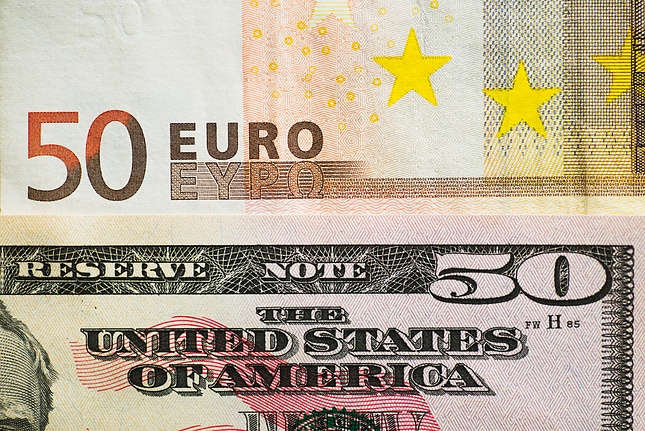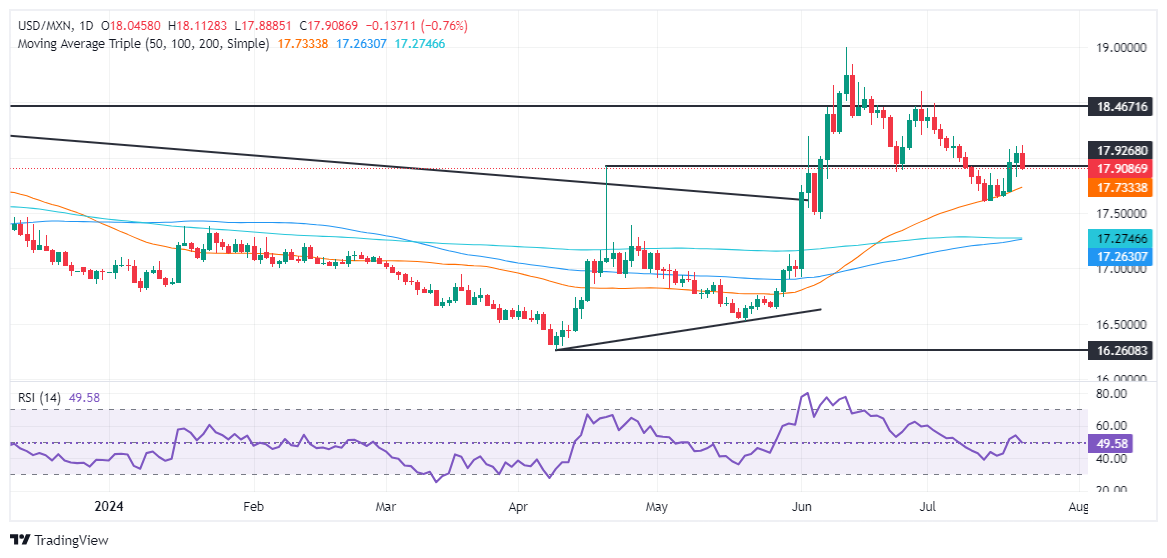- Mexican Peso gains 0.55%, trading at 17.92, after better-than-expected Economic Activity data.
- INEGI reports strong economic activity for May, offsetting slow retail sales growth.
- US political developments with Biden's withdrawal and endorsement of Harris impact market sentiment, favoring high-beta currencies.
The Mexican Peso recovered on Monday after ending the week with more than 2.30% losses. Mexico’s economic data was mixed, though the Economic Activity indicator, which measures growth, was better than expected and bolstered the Mexican currency. Therefore, the USD/MXN drops below the 18.00 figure and trades with gains of 0.55% at around 17.92.
The Mexican National Statistics Agency (INEGI) revealed that economic activity in May exceeded estimates and April's data on a monthly and annual basis. This helped the Peso, which remains appreciating against the US Dollar. Contrarily, Retail Sales for the same period increased slowly, hinting that Government infrastructure projects drive the economy.
Across the border, breaking news emerged on Sunday that US President Joe Biden dropped from the Presidential race and endorsed the current Vice President Kamala Harris to obtain the ticket of the Democrats and compete against former President Donald Trump.
After that, US equity futures opened higher during the Asian session, while Wall Street traded in the green. This undermined the Greenback and favored high-beta currencies like the Mexican Peso.
Last week, Trump’s comments put Mexico in the spotlight, commenting that he will end illegal immigration “by closing the border and completing the wall.” He added, “China and Mexico have taken 68 percent of our automotive industry, but we are going to get it back.”
The remarks threaten to prevent companies from relocating to Mexico, which could weaken the Mexican Peso.
The US Dollar Index (DXY), which tracks the buck’s value against the other six currencies, stays virtually unchanged at around 104.30.
Daily digest market movers: Mexican Peso recovers some ground
- Mexico’s Economic Activity in May increased by 0.7%, exceeding April’s -0.6% MoM contraction. On an annual basis, it slowed from 5.4% to 1.6%.
- May Retail Sales were worse than April’s, rising 0.1% MoM, trailing a 0.5% increase, and 0.3% YoY, down from 3.2%.
- The International Monetary Fund (IMF) adjusted Mexico’s Gross Domestic Product (GDP) expectations for 2024 from 2.4% to 2.2% due to the country’s economic slowdown and the US economic downturn.
- Fitch Ratings reaffirmed Mexico’s BBB- rating with a stable outlook but noted that the proposed judicial reform could impact the country. The credit rating agency expressed uncertainty about the upcoming administration's ability to narrow the fiscal deficit, anticipated a slight economic downturn in 2025, and mentioned that trade tensions with the US could leave Mexico vulnerable.
- The CME FedWatch Tools show that the chances of a quarter-percentage-rate cut to the federal funds rate in September are at 94%.
- June consumer inflation figures were lower than expected in the United States, increasing the chances that the Federal Reserve would lower borrowing costs in 2024 by at least 48 basis points, according to the December 2024 fed funds rate futures contract.
Technical analysis: Mexican Peso surges as USD/MXN slumps below 18.00
The USD/MXN retreated beneath 18.00; it seems to be poised to edge lower and test key support levels, the 50-day Simple Moving Average (SMA) at 17.72, the first support level.
Momentum shifted bearishly, as depicted by the Relative Strength Index (RSI), though it meanders around the 50-neutral line. That said, in the short term, the USD/MXN could be headed for a correction before resuming upwards.
If USD/MXN drops below the 50-day SMA, the next support would be the latest cycle low of 17.58; the July 12 high turned support. A breach of the latter will expose the January 23 peak at 17.38.
If USD/MXN extends its gains above the psychological 18.00 figure, that will expose key resistance levels. Once breached, the next stop would be the July 5 high at 18.19, followed by the June 28 high of 18.59, allowing buyers to aim for the YTD high at 18.99.
Mexican Peso FAQs
The Mexican Peso (MXN) is the most traded currency among its Latin American peers. Its value is broadly determined by the performance of the Mexican economy, the country’s central bank’s policy, the amount of foreign investment in the country and even the levels of remittances sent by Mexicans who live abroad, particularly in the United States. Geopolitical trends can also move MXN: for example, the process of nearshoring – or the decision by some firms to relocate manufacturing capacity and supply chains closer to their home countries – is also seen as a catalyst for the Mexican currency as the country is considered a key manufacturing hub in the American continent. Another catalyst for MXN is Oil prices as Mexico is a key exporter of the commodity.
The main objective of Mexico’s central bank, also known as Banxico, is to maintain inflation at low and stable levels (at or close to its target of 3%, the midpoint in a tolerance band of between 2% and 4%). To this end, the bank sets an appropriate level of interest rates. When inflation is too high, Banxico will attempt to tame it by raising interest rates, making it more expensive for households and businesses to borrow money, thus cooling demand and the overall economy. Higher interest rates are generally positive for the Mexican Peso (MXN) as they lead to higher yields, making the country a more attractive place for investors. On the contrary, lower interest rates tend to weaken MXN.
Macroeconomic data releases are key to assess the state of the economy and can have an impact on the Mexican Peso (MXN) valuation. A strong Mexican economy, based on high economic growth, low unemployment and high confidence is good for MXN. Not only does it attract more foreign investment but it may encourage the Bank of Mexico (Banxico) to increase interest rates, particularly if this strength comes together with elevated inflation. However, if economic data is weak, MXN is likely to depreciate.
As an emerging-market currency, the Mexican Peso (MXN) tends to strive during risk-on periods, or when investors perceive that broader market risks are low and thus are eager to engage with investments that carry a higher risk. Conversely, MXN tends to weaken at times of market turbulence or economic uncertainty as investors tend to sell higher-risk assets and flee to the more-stable safe havens.
Information on these pages contains forward-looking statements that involve risks and uncertainties. Markets and instruments profiled on this page are for informational purposes only and should not in any way come across as a recommendation to buy or sell in these assets. You should do your own thorough research before making any investment decisions. FXStreet does not in any way guarantee that this information is free from mistakes, errors, or material misstatements. It also does not guarantee that this information is of a timely nature. Investing in Open Markets involves a great deal of risk, including the loss of all or a portion of your investment, as well as emotional distress. All risks, losses and costs associated with investing, including total loss of principal, are your responsibility. The views and opinions expressed in this article are those of the authors and do not necessarily reflect the official policy or position of FXStreet nor its advertisers. The author will not be held responsible for information that is found at the end of links posted on this page.
If not otherwise explicitly mentioned in the body of the article, at the time of writing, the author has no position in any stock mentioned in this article and no business relationship with any company mentioned. The author has not received compensation for writing this article, other than from FXStreet.
FXStreet and the author do not provide personalized recommendations. The author makes no representations as to the accuracy, completeness, or suitability of this information. FXStreet and the author will not be liable for any errors, omissions or any losses, injuries or damages arising from this information and its display or use. Errors and omissions excepted.
The author and FXStreet are not registered investment advisors and nothing in this article is intended to be investment advice.
Recommended content
Editors’ Picks

EUR/USD holds above 1.0450 German sentiment data
EUR/USD stays in positive territory above 1.0450 after retracing a portion of its bullish opening gap. The data from Germany showed that the IFO - Current Assessment Index declined to 84.3 in November from 85.7, while the Expectations Index edged lower to 87.2 from 87.3.

GBP/USD pulls back toward 1.2550 as US Dollar sell-off pauses
GBP/USD is falling back toward 1.2550 in the European session on Monday after opening with a bullish gap at the start of a new week. A pause in the US Dollar decline alongside the US Treasury bond yields weighs down on the pair. Speeches from BoE policymakers are eyed.

Gold price manages to hold above $2,650 amid sliding US bond yields
Gold price maintains its heavily offered tone through the early European session on Monday, albeit manages to hold above the $2,650 level and defend the 100-period Simple Moving Average (SMA) on the 4-hour chart. Scott Bessent's nomination as US Treasury Secretary clears a major point of uncertainty for markets.

Bitcoin consolidates after a new all-time high of $99,500
Bitcoin remains strong above $97,700 after reaching a record high of $99,588. At the same time, Ethereum edges closer to breaking its weekly resistance, signaling potential gains. Ripple holds steady at a critical support level, hinting at continued upward momentum.

Eurozone PMI sounds the alarm about growth once more
The composite PMI dropped from 50 to 48.1, once more stressing growth concerns for the eurozone. Hard data has actually come in better than expected recently – so ahead of the December meeting, the ECB has to figure out whether this is the PMI crying wolf or whether it should take this signal seriously. We think it’s the latter.

Best Forex Brokers with Low Spreads
VERIFIED Low spreads are crucial for reducing trading costs. Explore top Forex brokers offering competitive spreads and high leverage. Compare options for EUR/USD, GBP/USD, USD/JPY, and Gold.
